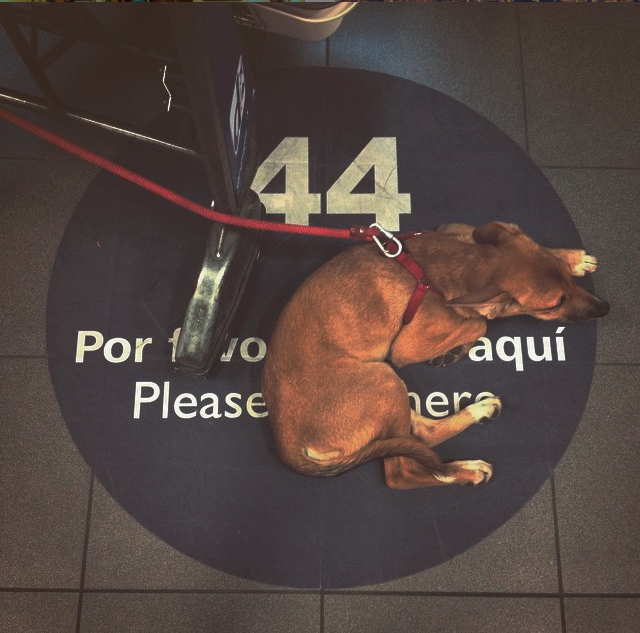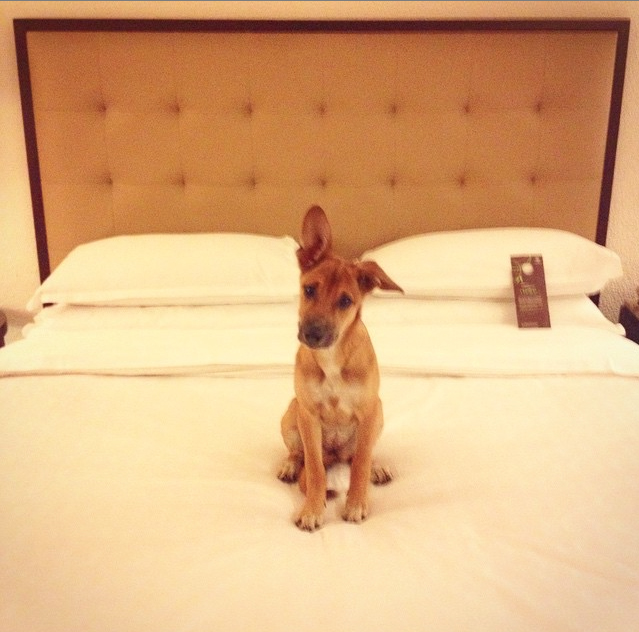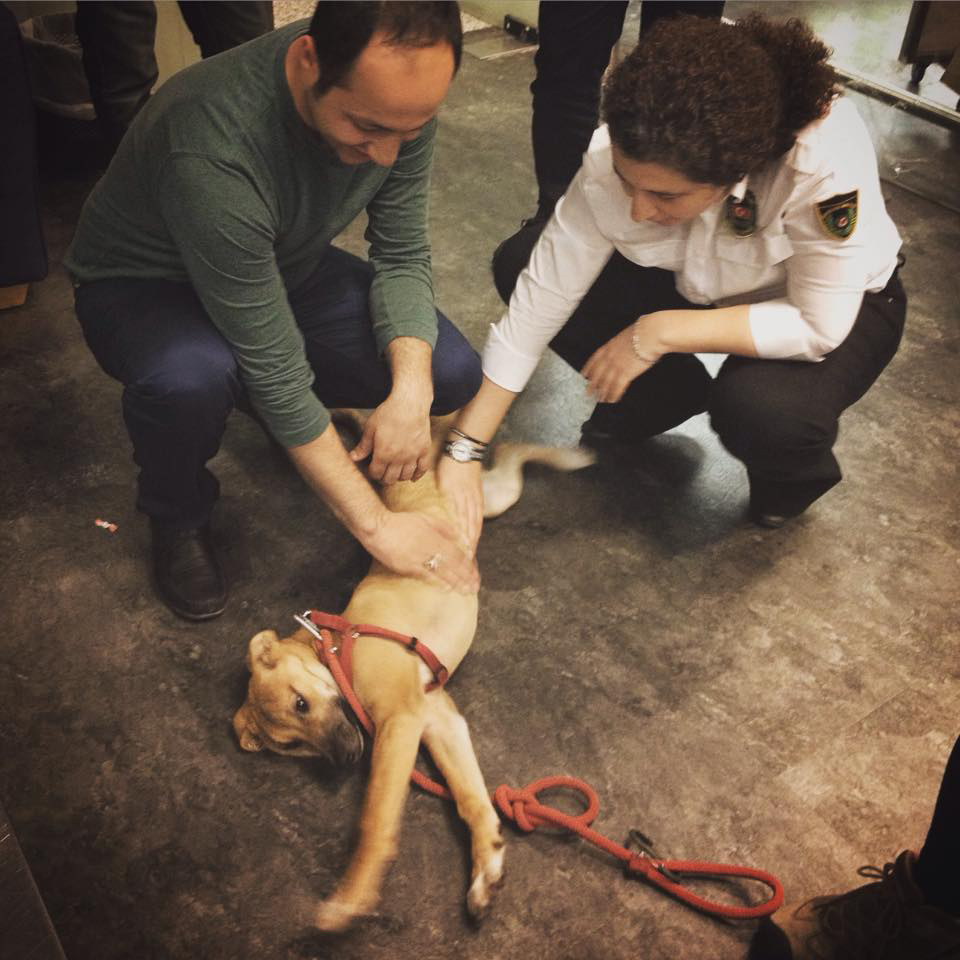Flying our Ecuadorian puppy Tara from Peru, over Brazil, to Turkey and back turned out to be as daunting and crazy of a task as it already sounds. The biggest challenge was that no one exactly knew how to do it. There are some helpful pet travel sites, but there is also a lot of misleading information online. Each country has such specific rules that it seems like a confusing bureaucratic jungle at first. In reality it’s fairly simple…
Going through the tedious process (aka nightmare) of figuring out all the requirements and paperwork and flying across the globe with our dog, we now know a few things more which we’d like to share…

Our now 8-months-old Amazonian street mutt Tara luckily didn’t mind the airport noise and the whole flying business. She was cool as can be and patiently waited in the designated areas.
THE THREE OPTIONS TO TRANSPORT YOUR PET ON AN AIRPLANE:
IN CABIN
An option for very small dogs which fit into a carrying bag underneath the seat. Most airlines have a weight limit of 6-8 kg.
The other exception that allows you to bring a dog into the cabin is, if it is a certified service dog. A dog like this needs to wear a muzzle and sit on the floor next to the owner. If it is ‘only’ an emotional support dog it may also be accepted but likely only for flights within the US. Although they should be obliged by law, not all airlines outside the US seem to honour the service dog exception, we suggest to find out ahead of time in case this applies to you.
IN A LIVE ANIMAL COMPARTMENT ON THE SAME FLIGHT
This is what we did.
This is a pressurised and air conditioned space and is not the same as the luggage compartment. This option requires you to have an airline approved crate with specific dimensions according to the airline requirements. From what we learned a range of 5-15cm of space above the head of your seated dog seems to be acceptable. Most veterinaries sell them. We just bought one that seemed large for her, to be safe. But, check the exact airline requirements, and buy a roomie crate. Some airlines have weight/size limitations for the crate+dog, so learn if this option works for your situation. Also some breeds (mostly short nosed) are not allowed on most airlines. Or puppies that are too young (under 4months or so).
SIDE NOTE: Regarding the care of the animals on board, we heard many mixed reports. During our flights, the animal cabin could not be accessed by the personell. But we were allowed to put a drinking station (the ones for hamsters). We also put some dry food into a plastic bottle with some holes, as a toy/food source. There are urine absorbent pads you can tape to the crate floor but they didn’t work too well. On the flight back we only put her bed and some toys. And we needed zip ties to lock the crate door. Some say it’s better to not feed them 6 hours before the flight so they don’t throw up. Most vets recommended not to tranquillise the dog unless it’s a very nervous one and you tested the effect of the medicine long before the flight. Our 5 then months old puppy Tara, ate and drank and stayed awake during the flight, and didn’t seem to mind the whole flying business too much.
IN CARGO
In this case the dog will be transported through a cargo specialist. This may be the cargo department of your airline. The cost is calculated through the volume of your crate, or the weight of it, whichever is bigger. This option was much more expensive and gave us a mini heart attack, until we learned that we were mislead. This may be the only way if the dog is too heavy. The preparations for this option may be slightly different since someone else “imports” the dog for you.
BOOKING YOUR FLIGHT AND MAKING A RESERVATION FOR YOUR DOG:
First make sure your dog has had a rabies vaccine within the last year, and not more recently than 30 days. Find out if the country you go to requires the FAVN report/titer test (European countries will likely require this. Peru, Brazil, and Turkey did not). FYI This test is expensive and takes time. Plan ahead.
Find a flight that works for you. (Direct flights of reputable airlines are best. Red-eye flights are great because the dog will naturally be tired. Long stop overs can be ok if there’s no direct flight. But read about the correct paperwork requirements further below. We would definitely not recommend short stop overs.)
Pick a flight that works for you. Call customer service of your airline to find out, if the specific flight/airplane you’d like to book allows the transportation of a dog in cabin or in the live animal compartment (depends on the size of your dog). Many flights with this kind of a compartment, only allow up to three live animals; and on board it may be as little as one. It’s good to book early. You’ll be asked your dogs breed, age, weight of dog+crate, and crate dimensions. So learn what size crate works for your dog and what it weighs beforehand. Ask for the price. They vary greatly from airline to airline.
We used a large Petmate crate for our 15kg dog. The crate itself weighed about 10kg.
If all is good, and there’s space for your dog, book the flight (online, via phone, or however you like), and then make the reservation for the dog via phone.
In our experience the costs ranged about a third of our own economy ticket and had to be paid at check-in. LAN airlines charged way more than Turkish Airlines. The crate was about $200.
GETTING THE TRAVEL PAPERS:
The hardest part was figuring out what papers we need. There was no direct flight, and we flew with a multiple day stop over in another country (to give us and the dog a break from the long journey). So it became tricky and no one could give us the correct information. We were told tons of things, down to having to get an endorsement from the embassy, and a titer test. Neither of it turned out to be necessary. So here it how it really goes:
STEP 1:
Learn from your veterinarian who the responsible office is for issuing an international health certificate. Likely it is some sort of agricultural department. Call this office and learn their requirements for issuing the international health certificate/export certificate for the destination country (+country of transit if you have a stopover). Also learn if you need to bring the dog and crate to their office for inspection and when to come.
In Lima Peru this place was SENASA, an agricultural office close to the airport. In Sao Paulo Brazil it was called MAPA, an agricultural department office directly inside the airport. And in Istanbul Turkey each municipality has an agricultural office that is responsible (this would be called Tarım İl Müdürlüğü or Tarım İlçe Müdürlüğü).
Likely this office will tell you to come by within 48 hours of the flight with all the correct papers (more to that later) to examine the dog+crate and get the international health certificate/export certificate issued. Only Peru actually inspected the dog before departure.
TIP: Learn from them the exact requirements for the health certificate you need from the veterinarian. For example: In Peru they required internal and external de-parasitation noted with name, exact dosage, and active ingredient + valid rabies vaccine. Also noting the correct age of the dog was very important. Any little mistake and you can make the trip to the airport with your dog and the big crate once again. In Brazil on the other hand, the thing that was most important to them was the stamp and the name of the veterinarian issuing the health certificate. Bureaucracy galore!
IMPORTANT: Your international health certificate is likely valid for 10 days. If you are traveling within those ten days, ask the agricultural office at the country of origin to issue papers for the destination country, with the stopover country noted as “in transit”. Insist. They can do it, even if they don’t know how to. Otherwise you’ll have to go through the same hassle again during the stop over, which happened to us. It’s a nightmare!!

We had a several day stop over in Sao Paulo. When we arrived late at night we learned that Peru had issued wrong papers to travel on (it should have said Brazil “in transit”), so we had to immediately drive to a 24h clinic to get a Brazilian health certificate, get up early the next morning to drive back to the airport to get the papers for Turkey. Luckily they had pulled strings for us and we immediately got an appointment before the weekend. We received the papers the same day which was a huge exception. Thanks Brazil!
STEP 2:
Go to your veterinarian and get a health certificate. These certificates are valid 10-15 days so time it according to your flight plans. Get it less than 10 days before your arrival date, to be safe.
Make sure your vet is noting all the requirements you’ve learned from the agricultural office. Likely your vet will know, but double check it, or have them call the office if they’re not sure which medicines, or dosages are allowed/required for the country you’re flying to. You don’t want to make the trip to the airport twice!
Buy some absorbent pads for the crate, and some Zip-ties, if you haven’t already. We also got a hamster water dispenser which Tara was happy about.
STEP 3:
Within 48 hours of your flight go to the office that will issue the export certificate/international health certificate. Most likely you’ll have to bring the dog in the crate, the health certificate, and vaccination papers. Bringe patience and some cash. Cross your fingers.
STEP 4:
Arrive at check-in 3 hours early (for international flights). Tell them you’re flying with a dog. Give them the international health certificate/export certificate + vaccination cards. Have them check once more if the aircraft indeed transports dogs. Pay their fee.
They will have you pay for the dog’s ticket and tell you what time to bring the dog. You can take your dog for a walk at this point. When the time comes, zip-tie the water station to the crate door, and bring the crate and dog to the required area. They may do an inspection or not. Zip tie the door shut. Tell your dog to wait and say good bye.

Sometimes airlines change the aircraft last minute. We went through the entire process, watched Tara being loaded into the plane, and during boarding they informed us that they had changed the airplane and can no longer transport the dog. So everything back out. Back through customs. Picking up luggage. We had to spend three late night hours in a hotel, go through all of it again, to catch the next flight in the morning. Moral of the story: it’s better to ask at checkin if there was any aircraft change. Tara didn’t mind the fancy bed though.
STEP 5:
Pick up your luggage and dog (likely at a special area for sporting goods/fragile goods etc). Go through the “declare” area at customs. Give them the dog’s papers.
In our experience the receiving-end wasn’t checking the papers very strictly at all. The Brazilians scribbled some stuff on a ripped piece of paper, the Turkish customs officials congratulated us for adopting a street dog and started petting her. The office that issues the papers for export is much stricter. Peru let us wait for hours and nearly gave us a nervous break-down. Brazil was much more humane. Turkey was easy too, on the way back.

Above is Tara at the Turkish Customs. We arrived late night, interrupting them playing backgammon and drinking tea. They came out of the office to pet her and congratulate us for adopting a street dog. What a nice welcome to Turkey! Especially considering that the rest of the country seems to have a inexplicable fear of dogs that results in many people screaming when they simply see one.
GENERAL DOG TRAVEL PREPARATION:
– VACCINES: Make sure your dog has an anti rabies vaccination which is less than 1 year old but not newer than 30 days before the flight. Bring all the vaccines up to date. No vaccine should be newer than 30 days.
Learn if the country you fly to requires a thither test (bloodtest/proof that the rabies vaccine worked). We got very misleading information about his. This test may take weeks up to months depending on where you are, and can be very costly, so find out early. (We were told Turkey requires it. They didn’t ask for the papers at all.)
– CRATE: Buy an airline approved crate in the correct size and train your dog to like it. Feed it inside, make it sleep inside. You can likely get this at your vet.
– HEALTH: Make sure your dog doesn’t have any unhealed cuts or bite wounds or anything that looks like a transmittable disease, or they may not allow it. If you have a nervous dog, find out from your vet if tranquillising it would be ok. Test it before the flight. In most cases it’s better not to.
The amount of information still seems intimidating, but it’s not as bad as it looks!
If you ignore the bureaucratic fine print, then a flight reservation, a veterinary, and the agricultural office, should be really all you need. Enjoy the treasure hunt and have a safe flight!
